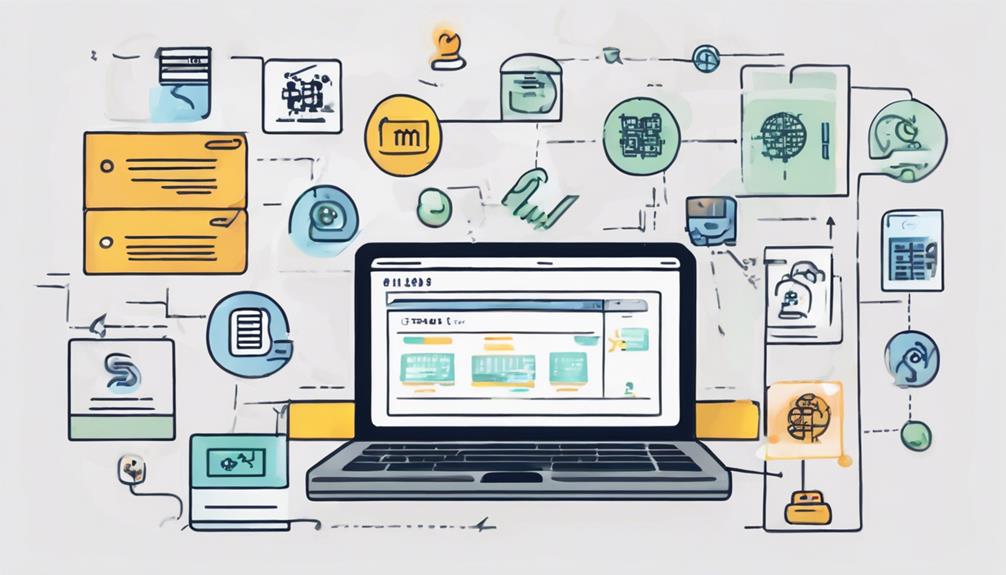It is essential for businesses to understand payment processing terms in order to enhance financial operations effectively. This includes knowledge of ACH processing for interbank fund transfers, credit card transactions with AVS verification, and key concepts such as CP and CNP transaction types. Additionally, mastering fees, penalties, and compliance obligations like PCI DSS is crucial for ensuring smooth transactions and data security.
Exploring technologies like EMV and NFC leads to optimized payment processing, reducing fraud risks. Strategies like automated ACH processing and managing invoice terms contribute to efficient payment management. Enhancing your knowledge in these areas can significantly improve your financial processes and overall business performance.
Key Takeaways
- Understand ACH and Credit Card Processing basics.
- Learn about Transaction Types, Fees, and Chargebacks.
- Comply with Regulations like PCI DSS and AML laws.
- Optimize Technology for secure transactions and efficient processing.
- Implement Strategies for Payment Processing efficiency and cost management.
Understanding Payment Processing Basics
What're the fundamental concepts behind payment processing that every business should understand?
Payment Processing Basics encompass a range of critical elements necessary for efficient financial transactions. ACH Processing stands out as a vital electronic payment network in the US, facilitating seamless fund transfers between financial institutions.
On the other hand, Credit Card Processing involves intricate services like Authorization and Address Verification Service (AVS) during transactions, with assessment fees directed towards card networks.
Understanding Transaction Types is crucial, distinguishing between Card Present (CP) and Card Not Present (CNP) transactions, each carrying unique implications such as cash discounts and chargebacks.
Additionally, being aware of Fees and Penalties is essential, given that credit card processing fees may include decline codes, interchange fees, early termination fees, and liquidated damages based on projected earnings.
Technology and Compliance play significant roles, covering aspects like EMV compliance, NFC technology, the FedNow instant payment system, ISVs, merchant accounts, and Payment Gateways' functions in ensuring secure and compliant payment processes.
Mastering these foundational concepts is key to navigating the intricacies of payment processing effectively.
Exploring Transaction Types and Fees

Let's delve into the world of transaction types and fees, uncovering the essential distinctions and financial implications for businesses.
In payment processing, transactions are classified into Card Present (CP) where physical cards are swiped, and Card Not Present (CNP) transactions made without the card present.
Interchange fees, paid to card networks like Visa and Mastercard, are crucial for processing transactions efficiently. Cash discounts serve as incentives for prompt payments, while chargebacks can occur due to disputed transactions, leading to funds being returned to the cardholder.
Debit cards differ from credit cards as they deduct funds directly from the cardholder's bank account. Understanding decline codes is essential as they indicate reasons for failed credit card transactions, potentially resulting in fees or penalties for merchants.
Navigating Compliance and Regulations
Navigating through the intricate landscape of compliance and regulations in payment processing demands meticulous attention to detail and unwavering commitment to safeguarding sensitive data and preventing fraudulent activities.
Payment terms aren't just about transactions and fees; they encompass a web of regulations like PCI DSS, GDPR, and AML laws that dictate how businesses handle customer data and prevent illicit activities such as money laundering. For example, the PSD2 regulation in Europe enforces strong customer authentication for online payments, enhancing security measures.
AML laws require financial institutions to perform customer due diligence, monitor transactions, and report any suspicious activities to combat money laundering effectively. Ensuring PCI DSS compliance is crucial for maintaining secure payment environments and protecting against data breaches that could have severe consequences, including hefty fines and reputational damage.
Optimizing Credit Card Processing Technology

Optimizing credit card processing technology involves implementing cutting-edge solutions to enhance transaction security and streamline payment processes for merchants and customers alike. EMV compliance is crucial for safeguarding payment data and reducing fraud risks.
By adopting NFC technology, businesses can enable contactless payments, providing convenience and speed across various industries. Understanding reason codes is essential to effectively manage chargebacks and minimize financial losses in credit card processing.
Maintaining PCI compliance standards ensures qualified processing rates, leading to lower fees and secure transactions for merchants. Refunds play a significant role in credit card processing, impacting merchant costs and financial transactions based on return policies.
Strategies for Payment Processing Efficiency
To enhance payment processing efficiency, we must implement strategies that streamline transactions and optimize cost management. Here are four key strategies to consider:
- Automated ACH Processing: Utilizing automated ACH processing can expedite fund transfers, supporting direct deposits and bill payments efficiently.
- Understanding Credit Card Transactions: Familiarize yourself with Card Present (CP) and Card Not Present (CNP) transactions to effectively manage different transaction types and optimize processing.
- Compliance with EMV Standards and PCI Compliance: Adhering to EMV standards and maintaining PCI Compliance not only enhances security but also aligns with industry best practices, ensuring efficient payment processing.
- Managing Payment Terms: Setting clear invoice payment terms, cash flow requirements, and expectations for early payment discounts is crucial to avoid late payment penalties and maintain financial control.
Frequently Asked Questions
What Are the Stages of Payment Processing?
We verify transactions in the authorization stage, move funds during clearing, and complete the process with settlement. Reconciliation ensures accuracy, and reporting provides detailed analysis. Each stage plays a crucial role in our payment processing system.
What Are the Steps in Payment Process?
We handle payment processing meticulously. Invoicing initiates the process, followed by payment submission through various methods. Verification ensures accuracy and compliance. Reconciliation matches payments with invoices. Finally, settlement concludes the process accurately and efficiently.
What Is the Payment Terms Process?
We negotiate and agree on payment terms with buyers. These terms specify due dates, payment methods, penalties, and discounts. Clear terms ensure smooth transactions, financial stability, and trust. Understanding this process is vital for managing cash flow effectively.
How Does Payment Processing Work?
We verify card details, authorize funds, and ensure data security to process payments. Different methods like ACH, credit cards, and debit cards have specific procedures. Compliance with standards like PCI DSS and EMV is crucial for reliability.
What Are the Key Terms to Master in Easy Payment Processing?
When it comes to mastering easy payment processing basics, there are a few key terms to understand. These include merchant accounts, payment gateways, and PCI compliance. By familiarizing yourself with these terms, you can navigate the world of payment processing more effectively and efficiently.
Conclusion
In conclusion, mastering payment processing terms is essential for businesses to operate efficiently and effectively.
While it may seem overwhelming at first, with proper understanding and implementation, businesses can navigate transaction types, fees, compliance, and regulations with ease.
By optimizing credit card processing technology and implementing strategies for efficiency, businesses can streamline their payment processing operations.
Don't let the complexity of payment processing terms deter you – with the right knowledge and tools, success is within reach.









